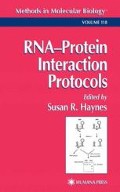Abstract
Methods of iterative nucleic acid selection and amplification were enabled by the invention of the polymerase chain reaction (PCR). Thus, the ability to amplify as few as a single DNA or RNA molecule made it possible to diversify sequences and to partition the desirable from the undesirable subset (Fig. 1A) (1,2). Initially, this approach was practiced in vivo using biological amplification and selection, by diversification of plasmid sequences and iterative growth against a selective marker (3). The power of in vitro RNA selection from a randomized combinatorial library was demonstrated by Tuerk and Gold (4) using T4 DNA polymerase and the R17 phage coat protein. These investigators called their iterative RNA selection procedure “SELEX.” Ellington and Szostak (5) also derived RNA ligands against organic dyes using iterative in vitro selection. Moreover, the demonstration that RNAs could be selected that bind to proteins and compounds with no known role in RNA-binding in vivo led to the concept of aptamers. An aptamer is a folded RNA that forms a shape that coincidentally fits against another surface, to which it is “apt” to bind. Generally, RNA ligands that bind to naturally occurring RNA-binding domains of proteins are not considered to be aptamers. Unexpectedly, an RNA ligand selected against an antibody generated by immunization with a peptide demonstrated that RNA and protein could crossreact at the level of antibody recognition (6).

(A) A schematic representation of the randomized RNA selection protocol. The sequences of the primers and template are given in (B). The T7 promoter region is labeled T7 pro. DNA and RNA are represented by double lines and single lines, respectively. The number of iterative cycles used varies with the nature of the target molecule and can allow evolution of the target set using error-prone PCR.
Access this chapter
Tax calculation will be finalised at checkout
Purchases are for personal use only
References
Oliphant, A. R., Nussbaum, A. I., and Struhl, K. (1986) Cloning of random-sequence oligodeoxynucleotides for determining consensus sequences. Gene 44, 177–183.
Oliphant, A. R. and Struhl, K. (1987) The use of random-sequence oligonucleotides for determining consensus sequences. Methods Enzymol. 155, 568–581.
Horwitz, M. S. Z. and Loeb, L. A. (1986) Promoters selected from random DNA sequences. Proc. Natl. Acad. Sci. USA 83, 7405–7409.
Tuerk, C. and Gold, L. (1990) Systematic evolution of ligands by exponential enrichment: RNA ligands to bacteriophage T4 DNA polymerase. Science 249, 505–510.
Ellington, A. D. and Szostak, J. W. (1990) In vitro selection of RNA molecules that bind specific ligands. Nature 346, 818–822.
Tsai, D. E., Kenan, D. J., and Keene, J. D. (1992) In vitro selection of an RNA epitope immunologically cross-reactive with a peptide. Proc. Natl. Acad. Sci. USA 89, 8864–8868.
Keene, J. D. (1996) RNA surfaces as functional mimetics of proteins. Chem. Biol. 3, 505–514.
Bartel, D. P., Zapp, M. L., Green, M. R., and Szostak, J. W. (1991) HIV-1 Rev regulation involves recognition of non-Watson-Crick base pairs in viral RNA. Cell 67, 529–536.
Tsai, D. E., Harper, D. S., and Keene, J. D. (1991) U1-snRNP-A protein selects a ten nucleotide consensus sequence from a degenerate RNA pool presented in various structural contexts. Nucleic Acids Res. 19, 4931–4936.
Levine, T. D., Gao, F., Andrews, L., King, P. H., and Keene, J. D. (1993) Hel-N1: an autoimmune RNA-binding protein with specificity for 3′ uridylate-rich untranslated regions of growth factor mRNAs. Mol. Cell. Biol. 13, 3494–3504.
Buckanovich, R. J. and Darnell, R. B. (1997) The neuronal RNA binding protein Nova-l recognizes specific RNA targets in vitro and in vivo. Mol. Cell. Biol. 17, 3194–3201.
Gao, F. B., Carson, C. C., Levine, T., and Keene J. D. (1994) Selection of a subset of mRNAs from combinatorial 3′ untranslated region libraries using neuronal RNA-binding protein Hel-N1. Proc. Natl. Acad. Sci. USA 91, 11,207–11,211.
Gold, L., Brown, D., He, Y., Shtatland, T., Singer, B. S., and Wu, Y. (1997) From oligonucleotide shapes to genomic SELEX: novel biological regulatory loops. Proc. Natl. Acad. Sci. USA 94, 59–64.
Kenan, D. J., Tsai, D. E., and Keene, J. D. (1994) Exploring molecular diversity with combinatorial shape libraries. Trends Biochem. Sci. 19, 57–64.
Lander, E. S. (1996) The new genomics: global views of biology. Science 274, 536–539.
Czarnik, A. W. and Keene, J. D. (1998) Combinatorial chemistry: a primer. Curr. Biol. 8, R705–R707.
Milligan, J. F. and Uhlenbeck, O. C. (1989) Synthesis of small RNAs using T7 RNA polymerase. Methods Enzymol. 180, 51–62.
Sambrook, J., Fritsch, E. F., and Maniatis, T. (1989) Molecular Cloning: A Laboratory Manual. Cold Spring Harbor Laboratory Press, Cold Spring Harbor, NY.
Chamberlin, M. and Ring, J. (1973) Characterization of T7-specific ribonucleic acid polymerase. 1. General properties of the enzymatic reaction and the template specificity of the enzyme. J. Biol. Chem. 248, 2235–2244.
Author information
Authors and Affiliations
Editor information
Editors and Affiliations
Rights and permissions
Copyright information
© 1999 Humana Press Inc.
About this protocol
Cite this protocol
Kenan, D.J., Keene, J.D. (1999). In Vitro Selection of Aptamers from RNA Libraries. In: Haynes, S.R. (eds) RNA-Protein Interaction Protocols. Methods in Molecular Biology™, vol 118. Humana Press. https://doi.org/10.1385/1-59259-676-2:217
Download citation
DOI: https://doi.org/10.1385/1-59259-676-2:217
Publisher Name: Humana Press
Print ISBN: 978-0-89603-568-3
Online ISBN: 978-1-59259-676-8
eBook Packages: Springer Protocols

